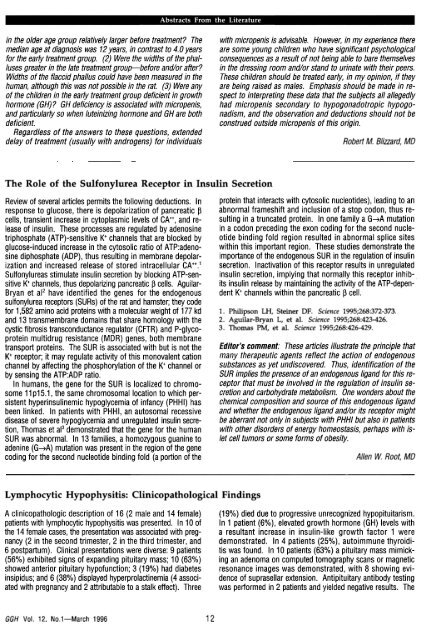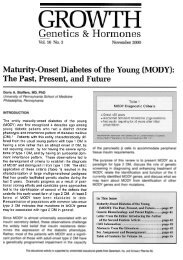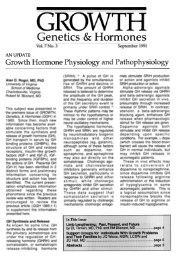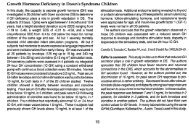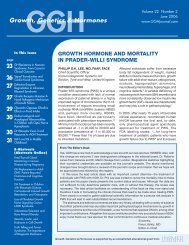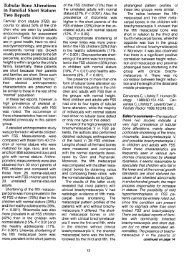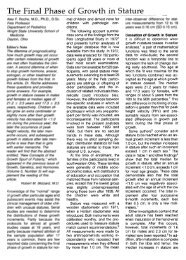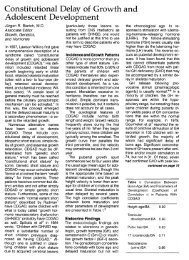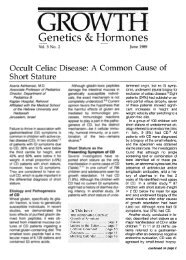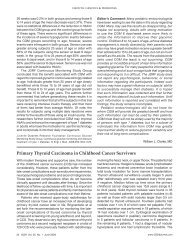Microphallus: Eventual Phallic Size Is Dependent on ... - GGH Journal
Microphallus: Eventual Phallic Size Is Dependent on ... - GGH Journal
Microphallus: Eventual Phallic Size Is Dependent on ... - GGH Journal
Create successful ePaper yourself
Turn your PDF publications into a flip-book with our unique Google optimized e-Paper software.
in the older age group relatively larger before treatment? The<br />
median age at diagnosis was 12 years, in c<strong>on</strong>trasto 4.0 years<br />
for the early treatment group. (2) Were the widths of the phalluses<br />
greater in the late treatment group-before and/or after?<br />
Widths of the flaccid phallus could have been measured in the<br />
human, although this was not possible in the rat. (3) Were any<br />
of the children in the early treatment group deficient in growth<br />
horm<strong>on</strong>e (GH)? GH deficiency is associated with micropenis,<br />
and particularly so when luteinizing horm<strong>on</strong>e and GH are both<br />
deficient.<br />
Regardless of the answers to these questi<strong>on</strong>s, extended<br />
delay of treatment (usually with androgens) for individuals<br />
with micropenis is advisable. Howevet; in my experience there<br />
are some young children who have significant psychological<br />
c<strong>on</strong>sequences as a result of not being able to bare themselves<br />
in the dressing room and/or stand to urinate with their peers.<br />
These children should be treated early, in my opini<strong>on</strong>, if they<br />
are being raised as males. Emphasishould be made in respect<br />
to interpreting these data that the subjects all allegedly<br />
had micropenis sec<strong>on</strong>dary to hypog<strong>on</strong>adotropic hypog<strong>on</strong>adism,<br />
and the observati<strong>on</strong> and deducti<strong>on</strong>should not be<br />
c<strong>on</strong>strued outside micropenis of this origin.<br />
Robel1 M. Blizzard, MD<br />
The Role of the Sulf<strong>on</strong>ylurea Receptor in Insulin Secreti<strong>on</strong><br />
Review of several articles permits the following deducti<strong>on</strong>s. In<br />
resp<strong>on</strong>se to glucose, there is depolarizati<strong>on</strong> of pancreatic ~<br />
cells, transient increase in cytoplasmic levels of CA++, and release<br />
of insulin. These processes are regulated by adenosine<br />
triphosphate (ATP)-sensitive K+ channels that are blocked by<br />
glucose-induced increase in the cytosolic ratio of ATP:adenosine<br />
diphosphate (ADP), thus resulting in membrane depolarizati<strong>on</strong><br />
and increased release of stored intracellular CA++.'<br />
Sulf<strong>on</strong>ylureastimulate insulin secreti<strong>on</strong> by blocking ATP-sensitive<br />
K+ channels, thus depolarizing pancreatic ~ cells. Aguilar-<br />
Bryan et ar have identified the genes for the endogenous<br />
sulf<strong>on</strong>ylurea receptors (SURs) of the rat and hamster; they code<br />
for 1,582 amino acid proteins with a molecular weight of 177 kd<br />
and 13 transmembrane domains that share homology with the<br />
cystic fibrosis transc<strong>on</strong>ductance regulator (CFTR) and P-glycoprotein<br />
multidrug resistance (MDR) genes, both membrane<br />
transport proteins. The SUR is associated with but is not the<br />
K+ receptor; it may regulate activity of this m<strong>on</strong>ovalent cati<strong>on</strong><br />
channel by affecting the phosphorylati<strong>on</strong> of the K+ channel or<br />
by sensing the ATP:ADP ratio.<br />
In humans, the gene for the SUR is localized to chromosome<br />
11 p15.1, the same chromosomal locati<strong>on</strong> to which persistent<br />
hyperinsulinemic hypoglycemia of infancy (PHHI) has<br />
been linked. In patients with PHHI, an autosomal recessive<br />
disease of severe hypoglycemia and unregulated insulin secreti<strong>on</strong>,<br />
Thomas et al3 dem<strong>on</strong>strated that the gene for the human<br />
SUR was abnormal. In 13 families, a homozygous guanine to<br />
adenine (G-tA) mutati<strong>on</strong> was present in the regi<strong>on</strong> of the gene<br />
coding for the sec<strong>on</strong>d nucleotide binding fold (a porti<strong>on</strong> of the<br />
protein that interacts with cytosolic nucleotides), leading to an<br />
abnormal frameshift and inclusi<strong>on</strong> of a stop cod<strong>on</strong>, thus resulting<br />
in a truncated protein. In <strong>on</strong>e family a G~A mutati<strong>on</strong><br />
in a cod<strong>on</strong> preceding the ex<strong>on</strong> coding for the sec<strong>on</strong>d nucleotide<br />
binding fold regi<strong>on</strong> resulted in abnormal splice sites<br />
within this important regi<strong>on</strong>. These studies dem<strong>on</strong>strate the<br />
importance of the endogenous SUR in the regulati<strong>on</strong> of insulin<br />
secreti<strong>on</strong>. Inactivati<strong>on</strong> of this receptor results in unregulated<br />
insulin secreti<strong>on</strong>, implying that normally this receptor inhibits<br />
insulin release by maintaining the activity of the ATP-dependent<br />
K+ channels within the pancreatic ~ cell.<br />
1. Philips<strong>on</strong> LH, Steiner DF. Science 1995;268:372-373.2.<br />
Aguilar-Bryan L, et al. Science 1995;268:423-426.<br />
3. Thomas PM, et al. Science 1995;268:426-429.<br />
Editor's comment: These articles illustrate the principle that<br />
many therapeutic agents reflect the acti<strong>on</strong> of endogenous<br />
substances as yet undiscovered. Thus, identificati<strong>on</strong> of the<br />
SUR implies the presence of an endogenous ligand for this receptor<br />
that must be involved in the regulati<strong>on</strong> of insulin secreti<strong>on</strong><br />
and carbohydrate metabolism. One w<strong>on</strong>ders about the<br />
chemical compositi<strong>on</strong> and source of this endogenous ligand<br />
and whether the endogenous ligand and/or its receptor might<br />
be aberrant not <strong>on</strong>ly in subjects with PHHI but also in patients<br />
with other disorders of energy homeostasis, perhaps with islet<br />
cell tumors or some forms of obesity.<br />
Allen W. Root, MD<br />
Lymphocytic Hypophysitis: Clinicopathological<br />
A clinicopathologic descripti<strong>on</strong> of 16 (2 male and 14 female)<br />
patients with lymphocytic hypophysitis was presented. In 10 of<br />
the 14 female cases, the presentati<strong>on</strong> was associated with pregnancy<br />
(2 in the sec<strong>on</strong>d trimester, 2 in the third trimester, and<br />
6 postpartum). Clinical presentati<strong>on</strong>s were diverse: 9 patients<br />
(56%) exhibited signs of expanding pituitary mass; 10 (63%)<br />
showed anterior pituitary hypofuncti<strong>on</strong>; 3 (19%) had diabetes<br />
insipidus; and 6 (38%) displayed hyperprolactinemia (4 associated<br />
with pregnancy and 2 attributable to a stalk effect). Three<br />
Findings<br />
(19%) died due to progressive unrecognized hypopituitarism.<br />
In 1 patient (6%), elevated growth horm<strong>on</strong>e (GH) levels with<br />
a resultant increase in insulin-like growth factor 1 were<br />
dem<strong>on</strong>strated. In 4 patients (25%), autoimmune thyroiditis<br />
was found. In 10 patients (63%) a pituitary mass mimicking<br />
an adenoma <strong>on</strong> computed tomography scans or magnetic<br />
res<strong>on</strong>ance images was dem<strong>on</strong>strated, with 8 showing evidence<br />
of suprasellar extensi<strong>on</strong>. Antipituitary antibody testing<br />
was performed in 2 patients and yielded negative results. The<br />
<strong>GGH</strong> Vol. 12. No.1-March 1996<br />
12


